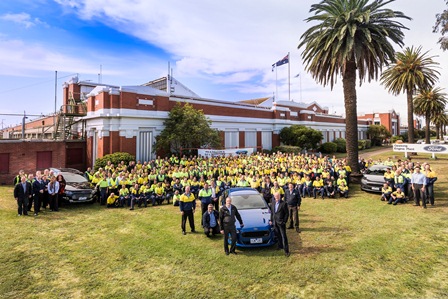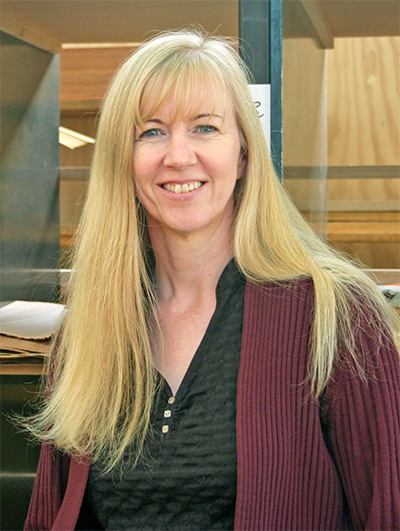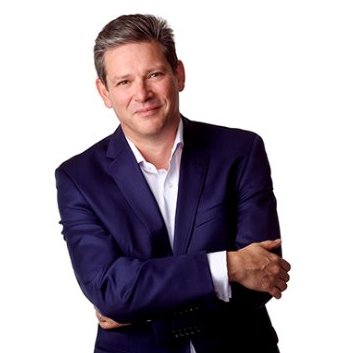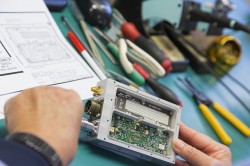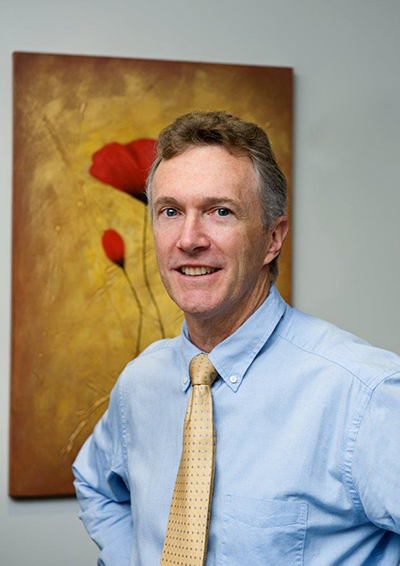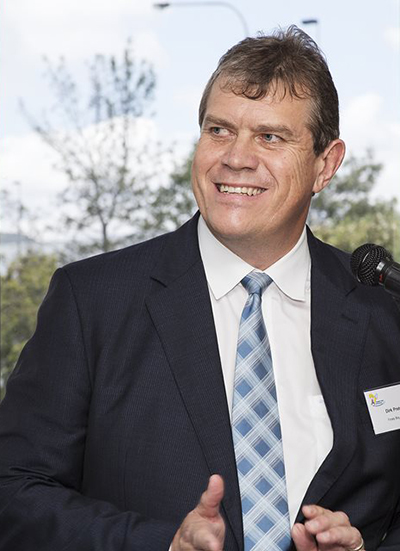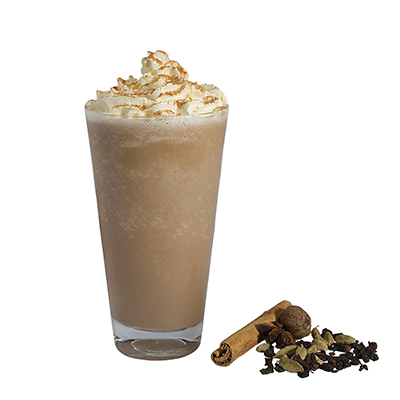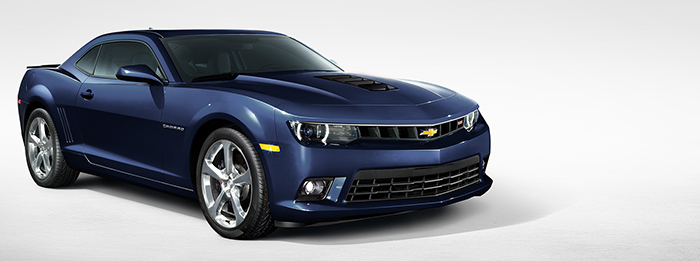
By Mike Sullivan
TECHNOLOGY diffusion organisation QMI Solutions is adamant manufacturing has an extremely bright future in Australia – but not as we have known it.
QMI Solutions chief executive Gary Christian believes the demise of the major automotive manufacturers in Australia has blindsided the community and most politicians to the real opportunities and competitive advantages Australian manufacturers retain – and need to develop hard and fast.
“Is it advanced manufacturing or is it ‘advancing’ manufacturing?” Mr Christian asked. “I think we are advancing it to the next level.”
Mr Christian made the point in relation to world leaders in manufacturing, based in Australia, that are doing it very differently – companies like defence contractors Micreo and Ferra Engineering, marine manufacturers Riviera and Maritimo, composite materials manufacturer Wagners, global medical device designers and producers Cook Medical and Cochlear, and architectural doors innovator Centor.
All are leaders in their manufacturing fields and going from strength-to-strength, Mr Christian said. Other up-and-coming companies can learn from them. He believes the decline in major car production and the falling away of the mining sector infrastructure boom may actually play into the hands of other Australian manufacturing sectors, long term.
“When a big resource boom pops up, there is a big drain on skills automatically – they all head out west to capitalise themselves, I suppose, on the growth they experience there,” Mr Christian said. “And you see a skills drain in the cities.
“I think the Australian auto industry has done some great things in the last few years. We have some pretty smart stuff in our cars now … they talk about cars starting to park themselves, well, Audi have done it and Holden are doing it. We got there. I think it’s sad that we got there when the market started to shrink around us.
“You are taking about the in-car componentry – well, that’s electronics so that’s transferable.
“Over the next few years I think we will see a transfer of those skills to other industries. It may be the medical area, for instance, and we have a very good medical device manufacturing industry here.”
AUSTRALIAN CONDITIONS
The impetus to make motor cars in Australia in the first place came from the need to make vehicles for ‘Australian conditions’ – in fact, that was the catchphrase that General Motors-Holdens Sir Laurence Hartnett and Jack Horn used when convincing the GM board to establish Australian-design and manufacturing in 1944. The pair also made their proposal with the full knowledge that at that stage the Holden operation was the most efficient manufacturing plant in the entire General Motors network.
But ‘Australian conditions’ involved more than just the vast distances to be travelled, the wide temperature variations and the rugged state of most roads at the time. They also referred to Australia being a small but relatively sophisticated market, a long way from the world’s major industrial centres, and with a need for innovative engineering for reliability and to overcome the tyranny of distance.
While the increased cost of labour and fluctuations in the Australian dollar may have cruelled the great auto manufacturers, the design-led innovation that has been a characteristic of Australia’s auto industry for more than a century – witness Ford Australia’s famous creation of the ‘ute’ and Australia’s expertise in braking and cooling systems – will keep the industry here. Both Ford and GM are holding and expanding their design and prototyping assets in Melbourne.
Holden has just completed the final designs for the new Buick range – a car that will not even be sold here, as has been the case with its famed latest generation Camaro development program. Aftermarket accessories manufacturers like EGR are expanding their markets in utility canopies and off-road accessories.
“If you are a component manufacturer and you are good enough to compete in a global market – and that’s getting a whole lot of things right in your business so you are competitive—I think that you can collaborate with others and be an end-user supplier to the auto market. I can definitely see that,” Mr Christian said. “A little bit of auto capability is going into marine industries.
“We have come across a lot of great companies operating in the aviation space over the years. I suppose defence takes up a lot of that,” he said.
“If you look at where we see the growth, you look at aviation, medical devices, and to some point even in marine. Even though you may get the (marine vessel) shells made elsewhere, we still have to do the fit-outs, and the electronics (made and fitted) here.
“So I think the electronics (design-manufacture) area will be a huge flow through for us as we go forward.”
HOME GROWN INNOVATORS
Mr Christian said one sector in which Australia has a distinct lead already, agribusiness, is also perhaps its greatest manufacturing opportunity – both in food manufacturing systems and in farm management technologies.
He mentioned the world-leading research being conducted by Central Queensland’s Swarm Farm group on agricultural robotics, in tandem with the Queensland University of Technology (QUT).
Swarm Farm founding director Andrew Bate believes specific robotics can be applied to farming to make it more efficient and eliminate the need for pesticide use by using robots to tend to plants on an individual basis, while also tending the soil – and it can all be done 24 hours a day, seven days a week in any weather conditions. He set out several years ago on a global quest from his Central Queensland family farm to seek out such state-of-the-art systems – only to find that QUT was actually leading the world in this area, so Swam Farms is now a collaborator in developing a series of agricultural robots, now dubbed AgBots.
“He was very focused on not losing his skills and trying to grow the skills to actually pick up the new technologies and putting them into his business,” Mr Christian said. “They are doing well. It’s a processing manufacturing business with the farming. They are one of those stand-out companies that are really embracing the technology.”
Another stand-out design-led company QMI has worked with is Centor. The company is a world leader in sliding and folding door systems and is now one of the world’s leading designers and manufacturers in this area.
“They are one that has made a major transformation over the past four or five years,” Mr Christian said. “We worked alongside the State Government up here to launch a program – the Ulysses program – to help design their transformation.
“To talk to the managing director Nigel Storm about their transformation, it’s a great story about how one day he just went forward on changing his customer base. The business had grown to a point where it was being eroded, so he changed his whole customer base over to more of a direct relationship with the end user – the consumer.
“If you talk about the bi-fold sliding door systems, probably some of the best products I have ever seen would be coming out of Centor ... to the point that he has entered the North American market and his business is growing at a phenomenal rate.
“That is a great example of how a business was able to transform from what they had been doing for many, many years; taking their product range back to what the end user really wanted. I suppose cutting out the middle man in the large end of town and dealing more with the smaller customer (builders and end-users).
“When we first approached them on behalf of the State Government to see if they would do a pilot program, I think there were a lot of vacant looks around the room, trying to understand this design-led concept and what it really meant. But having said that, by the time we got to the next round of discussions with them, they were very interested.
“They knew they had to do something different, because they could see their own balance sheet and they could see their profits. Things were shrinking because of who they were dealing with (at that time),” Mr Christian said.
“Now it has completely turned around to the point where profits are growing based on who they deal with, which is that end customer,” he said.
“Talking about Centor, that whole design led concept is starting to emerge. All companies are asking, what is this transformation of my business model to be better at what I do? Who is the end user? Where am I on my designer journey?”
HELPING MANUFACTURING
Mr Christian believes governments need to get behind rejuvenating manufacturing, but in a way that is consistent with a 21st century industry. He said manufacturing is and should remain a vital pillar of economic growth in Australia.
“I think government needs to understand the importance of manufacturing – the number of jobs it creates and the overall effect it has on GDP in our country,” Mr Christian said. He uses the recent manufacturing recovery in the US as an example.
“It is interesting when you look at what happened in America over the last couple of years. They had outsourced so much and then they started taking it back in again. They were probably taking the high value products that were more highly automated back in, but they have concentrated on creating more manufacturing and bringing more jobs back internally and it has assisted in turning the economy back around.
“For every manufacturing job there are another five created in the supply chain. Every time manufacturing is not looked at and starts to wind down those volumes, there is a huge flow-on effect. Most people in manufacturing know that.
“I watch the federal scene and it is interesting that we are now going to pump more money back into the auto industry again. Something has happened that people have realised we can’t step back, we have to take things more aggressively and be on the front foot and support our manufacturing – it needs to be a transitional thing.
“It is not something that happens overnight, it could take 10 or 20 years to do that efficiently.”
The outlook right now is hardly bright, Mr Christian admitted and he said as far as QMI could observe there was no appreciable increase in manufacturing start-ups at this stage.
“I think overall it is static – I am seeing some movement there, but not enough to be confident in saying people are starting to want to start up in manufacturing,” he said.
“We have been through X number of years in which manufacturing has largely been attracting negative comments, in a phase that is largely driven by the big end of town.
“Australia is made up of about 96 percent SMES, so most of our manufacturing is done by smaller businesses, between 20 and 200 employees and in that $40-60 million bracket. Those are the ones that actually do transform and become bigger companies down the track. Small business is important because it becomes medium sized business and medium sized business becomes bit business.
“So government does need to support small business but there always comes a point where they need to stand on their own two feet – the issue is what is the point where you stop supporting?”
There has been a prevailing view that Australian banks and their business loan programs are not conducive to manufacturing growth – but Mr Christian did not see it that way.
“We talk to banks because we like to represent manufacturing, and there is interest,” he said.
“Some of the smaller guys (banks) are certainly focused on trying to engage with that SME market. The comments that we get are that they are very focused on manufacturing help. I have not been getting that negative feel that banks are not wanting to finance manufacturing.
“It’s like anything, the business has to be able to stack up to the bank because if you are a start-up company and you are really only doing this because it is a passion and you do not understand business, you become a high risk to the bank.
“We have a lot of processes in QMI where we have benchmarked organisations to give banks that confidence. Those sorts of business tools and benchmarking give companies the confidence and banks the confidence – and provide the documents that assist greatly in front of a banker.
“We tend to go through and benchmark them on the core things in their business. We have done over 1400 benchmarks alone in Queensland in the last 10 years. We can talk openly and honestly about what our findings have been.”
A recent innovation at QMI will play an increasing role in improving business development and helping to make positive cases for finance, Mr Christian said.
“Recently we brought a new product out to the market, Core Value software out of the US, and it is a lot better benchmarking tool again,” he said. “What that is doing is helping companies to make the decision on whether they need to stay in the game or hop out. It goes a lot more into the financial measures of a business.”
He has seen Core Value successfully applied to make a compelling manufacturing finance case to a bank.
“Of companies I have seen over the years, some successful and some not, it always comes back to the skill set in the business,” Mr Christian said. “They are companies formed out of their tech background, I suppose. So they had a passion for what they did.
“Some of them are lucky along the road and had gotten to learn about business and survived – and some didn’t. Those could never get past that ‘I bought myself a job’. It’s unfortunate. But most business people have had to learn along the hard road. A lot of them didn’t go to university – but even those that did often were not prepared for business and it was only by getting into the business and running it that you actually learn.”
BUSINESS HELP
While the challenges to successful manufacturing in Australia are there, Mr Christian said help was available from an increasing range of sources as well.
“There are a lot of places you can go,” he said. “The Federal Government runs the Infrastructure Entrepreneurial program, and they come in and do business reviews around the country. These can be very useful.
“State-wise there is QMI Solutions. We have been here for over 22 years now and we have been supporting new businesses for all of that time, whether it be the uptake of new technologies or the implementation of new soft technologies to actually help them get better at what they do.
“Along that path we have benchmarked those companies to help them realise where they are at and what they need to do.”
QMI’s roots are in leading the way with new manufacturing technologies – it was originally known as the Queensland Manufacturing Institute – and then diffusing those technologies to commercial industry. A good example is its early diffusing of 3D printing technologies, which are now coming to the fore.
“Back in 1993 we were funded by the State Government to take up the stereolithography which was a form of 3D printing,” Mr Christian said. “That technology, which you see everywhere now in 3D printing, was a sizeable machine in those days and it as good for prototyping your products or testing existing products.
“It was a great spin-off technology and there was another company formed out of that called Anatomics and they operate largely in the cranial facial reconstruction area, with medical parts. So there were some really good stories that came out of the forming of QMI and the relationship with Anatomics – and now we see that technology talked about almost every day.”
In fact the two lading medical manufacturers in Australia, Cook Medical and Cochlear, are now adapting 3D printing technologies for their products, to maintain a world lead.
“Cochlear and Cook Medical are both heading that way (3D printing),” Mr Christian said. “At the end of the day, to be able to prototype some small part to get a better feel for it, and it is quite inexpensive to do that, as opposed to the huge outlay. The original 3D printing that we had 20-odd years ago was not $1200 that you pay today, let’s put it that way. It was a significant investment made by QMI and the State Government to be able to bring that technology to this country.
“When you talk about 3D printing (in the future) we can look at the whole concept of growing organs – instead we can be 3D printing them. That’s real. That’s going to happen.
“Same with 3D laser sintering, printing in 3D with powders, they are technologies that will grow more; 3D printing within a few years will be something we talk about as past … it will have migrated and transformed into the new age of printing – even body parts.
“They have printed a car already overseas. So 3D printing is transforming and while it is industry picking it up now, who is to say that in a few years time you won’t have a printer that you pick up from Harvey Norman for $1000 that you could print your own knob that just broke on your air conditioner? Downloadable.
“Where is it going to go? This is something we are watching carefully to see where this technology is really going to end up. We have already seen the police getting alarmed about people making their own firearms using 3D printers.”
Mr Christian said Australia’s peak science organisation, CSIRO, is heavily involved in 3D printing innovation and its learnings are likely to be taken up by industry. An unusual example was a specific horseshoe CSIRO designed and printed, which ended up saving a horse’s life.
“They were aware of a horse that was likely to be put down, but CSIRO but ended up keeping it alive by making a specific horseshoe, because they discovered one of the horse’s legs was just slightly shorter than the other. That’s technology for you.”
Mr Chrisitian highlighted the value of pure research, even if it was not clear in the early stages how this would play out commercially.
“Some of the things we diffused to this country never really took hold until some years later,” Mr Christian said. “It was on a curve in which we researched and were able to diffuse that technology and, ready for when it really got its full commercial take-up.
“For example, we have an incremental sheet forming machine housed out at the University of Queensland, and they have been doing a lot of work with Boeing over the years – Boeing are a big recipient or interested party on the research side of incremental sheet forming.
“I wonder sometimes, if in 10 years time suddenly everyone is going to be talking about incremental sheet forming, yet we have had the only one in this country for the last nine years.
“I’ve talked to manufacturers over here who may have an applications for it … they don’t understand it, yet. But they can see how it can help their business.”
Mr Christian said Australian industry often struggled with new technology adoption.
“It’s difficult,” he said, “you have really got to try to get them to embrace.
“This is a new technology, you need to stop working in your business and start to work on it – there is an application here that can save you a lot of money and make you more competitive.
“I find that in Australia: some companies struggle with that take-up of technology.”
In some ways, QMI sees resurgence in Australian manufacturing as a ‘back to the future’ process.
Australia has a fine record of invention: the lawn mower, the black box flight recorder, the Cochlear ear implant, Gardasil vaccine, over-the-horizon radar and, perhaps most commercially impactful of all, CSIRO’s creation of wi-fi. An exciting new development in Australia is wireless power connection technology, Mr Christian said.
“We have been starting to get some interest in this kind of area – the whole idea that your mobile phone can just sit there on the desk and charge while you are having a cup of coffee …” he said. “I think this whole wireless transmission of electricity is going to be a huge growth area. I think there is still room to move in other areas like solar panels – for example, why doesn’t Australia have solar roofing, say the whole roof of your house?
“I am lucky enough to run across a lot of great companies doing great things. I ran across a gentleman recently who had a way of charging (electric) buses. As a bus pulled up at a bus stop, it was charging. On to the next stop, charge. They had worked out how many minutes the bus stopped.
“I was also talking to a gentleman the other day who can scan underneath the bitumen at 100kmh for holes. So think about the floods we have over here, we can scan along at 100kmh, scanning 8ft (2.5m) down. It’s a great invention, but once again it is hard to get the right kind of investment in these companies.
“They have a great concept but trying to get funding to take it to the next level and commercialise it is very difficult for them. Trying to get somebody to fund this sort of thing in Australia is very difficult, because of the population.
“There are only 23 million of us here, living in a place bigger than America. That’s the problem. These things will happen, but they are more likely to happen (commercially) in other countries before they happen here.”
Mr Christian said this was the ongoing Australian dilemma, where new inventions and innovative companies go offshore because they can only find funding offshore. For manufacturers, the reality is that they usually must locate to where they are funded – and that is where the jobs are created.
There are many challenges to Australian manufacturing, but Mr Christian remains optimistic about the future.
“I think it is a period of time that we are going back to again – but in different ways,” Mr Christian said. “We will see that large scale mass manufacturing, which we have had here for the past 200 years, will scale down while new niche manufacturing will emerge. Through robotics, 3D printing etc.
“Is it advanced manufacturing or is it ‘advancing’ manufacturing?” Mr Christian asked. “I think we are advancing it to the next level.”
www.qmisolutions.com.au
Ends
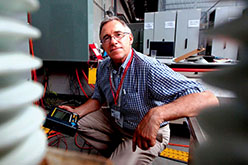

 How to resolve AdBlock issue?
How to resolve AdBlock issue? 